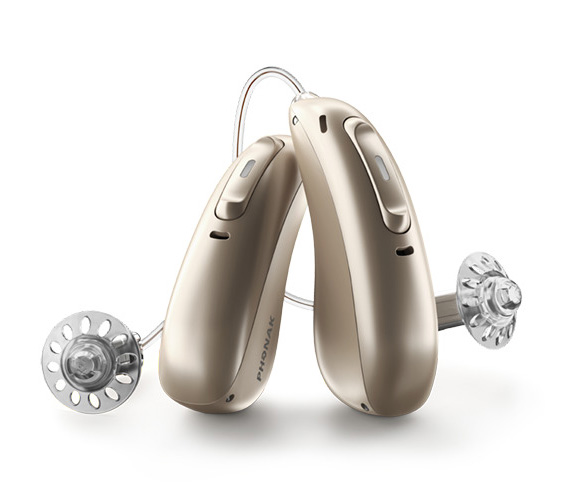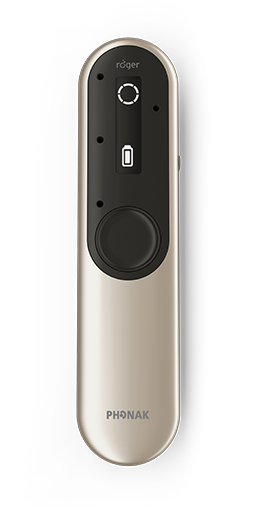Hearing Technologies for Auditory Processing Disorder
Currently, there are two primary hearing assistive technology options for individuals with an auditory processing disorder: personal remote microphone systems and low-gain hearing aids. When low-gain hearing aids are recommended, these should be combined with an accessory remote microphone for maximum benefit.
Why Hearing Technology Can Be Helpful for APD
Most individuals with an auditory processing disorder have normal hearing sensitivity. They will pass a standard hearing test but have significant problems understanding speech due to faulty neural pathways between the ears and the brain. Their ears work so they can physically hear what is being said. The problem appears when the message is sent to the brain to be interpreted. Along the route to the brain, the message gets distorted or disorganized, resulting in a tendency to misunderstand what was said. Many individuals with APD struggle to distinguish similar-sounding speech sounds, especially when listening in noisy conditions. It often takes individuals with APD longer than the average person to process what is said to them, leading to frustration and listening fatigue from trying to keep up with ongoing speech.
Mild amplification (through personal remote microphone systems or low-gain hearing aids) helps people with APD, even though their pure tone audiogram may be normal. Research suggests slight amplification helps overcome dyssynchrony so that speech is perceived clearly.
What are Low-Gain Hearing Aids?
Low-gain hearing aids are not a particular class of hearing aids. Instead, they are a specific method of fitting hearing aids for children and adults with normal to near-normal hearing who struggle with an auditory processing disorder. Many studies now document the benefits of low-gain hearing aids for individuals with auditory processing disorder and people with normal peripheral hearing sensitivity with self-reported hearing problems.
Remote Microphone Systems
Most research on hearing technology for APD has been on remote microphone systems such as Roger Focus II. These systems are not hearing aids. Instead, the teacher/primary talker wears a microphone to send their voice directly to tiny earpiece receivers worn by the listener. The direct input brings the talker’s voice closer. The mild amplification helps ensure that soft consonant sounds that are too weak to travel across the room are heard clearly, and distracting background noise is reduced.
There is strong evidence that remote microphone systems like Roger Focus II benefit most, if not all, children with APD (and many with ASD, dyslexia, and other disorders) and adults with various types of auditory processing disorders. There is a double benefit – both assistive (immediately assisting hearing) and therapeutic (permanent improvement in hearing skills over time), making hearing technology a powerful treatment for APD. However, these systems are most beneficial for hearing the teacher in school and are not a solution for all environments outside the classroom.
Low-Gain Hearing Aids Combined with a Remote Microphone

Low-gain (mild strength) hearing aids combined with remote microphones are often the best approach over a traditional FM system and hearing aids alone for auditory processing disorder (APD). Recent research shows very promising results due to the many benefits to this combination of technology. The main advantage is that the individual with APD wears hearing aids all the time and still gets some help when the transmitter microphone is not being used.
At Auditory Processing Center, we do not typically recommend hearing aids without remote microphones for children with APD because of the limited peer-reviewed evidence and poorer performance in noise compared to when the remote microphone is used. For example, hearing aids alone can only provide a 5dB signal-to-noise ratio. In contrast, a Roger remote transmitter microphone can provide a 20dB signal-to-noise ratio (meaning the primary talker’s voice is 20dB louder than competing background noises). This remote microphone is very beneficial in bypassing the effects of distance, reverberation (echo), and interfering noise, which can degrade a speaker’s speech. Yet, traditional FM/DM systems do not provide benefits unless a primary talker is wearing the microphone. With a combination of a remote microphone and low-gain hearing aid technology, the listener can experience the best of both worlds in many cases. Hearing aids with directional microphones and noise algorithms can be worn everywhere without the constraint of the wearer always needing to pass a separate remote microphone to the talker. Combining this technology can facilitate a child’s ability to follow class discussions. At the same time, the teacher’s voice is still given priority by using the remote microphone. It can also assist the child in socializing with peers in the halls, cafeteria, and in other situations when the teacher’s microphone is not being used.
Additional Benefits of Low-Gain Hearing Aids for APD
Additional advantages of low-gain hearing aids for APD include easy connectivity streaming and advanced hearing aid features not offered in the Roger Focus II product. Bluetooth technology in low-gain hearing aids can automatically connect to a cell phone and iPad, providing easy connectivity to computers for online learning. The listener also benefits from additional hearing aid features that offer comfort in loud noise, speech enhancer features to make soft voices easier to hear, algorithms to help follow conversations from any direction, motion sensors to provide better audibility while walking, and features to suppress car and road noises, and wind noise. Research on this combination of technology has documented improvements in speech understanding in noise, speech from a distance, confidence with social interaction, self-esteem, and everyday listening.
The Importance of Programming Expertise and Support
The programming of low-gain hearing aids for individuals with auditory processing disorder (APD) should be carried out by an audiologist with specialized experience in fitting these devices for people with normal or near-normal peripheral hearing. Programming hearing aids for APD is not the same as fitting for typical hearing loss. When properly fitted in individuals with normal peripheral hearing, low-gain amplification helps improve auditory neural synchronization, making speech clearer and easier to process.
Poorly fitted devices, on the other hand, may lead to distorted sound perception and increased listening fatigue. Excessive amplification can actually distort sounds, making speech even harder to understand. The audiologist must balance enhancing soft sounds, especially speech in noise, while avoiding any unnatural loudness.
APD patients with normal hearing thresholds need very specific, subtle amplification to improve speech perception without distorting environmental sounds and making loud sounds uncomfortable. Audiologists experienced with amplification for APD will know how to avoid this by focusing on clarity, not loudness. Settings must be optimized to avoid overamplification, as well as using directional microphones, noise management, and remote microphone integration to improve the listener’s ability to distinguish speech in noisy environments.
Expert Care with Proven Results
We provide expert care for every patient with low-gain hearing aid fittings and personalized support for optimal outcomes. The initial fitting must be done in person at our clinic to ensure precise settings customized to each individual’s unique needs. However, we offer remote support for troubleshooting and minor adjustments. Upon purchasing hearing aids, patients receive a 30-day trial period for evaluation. Additionally, the hearing aids come with a five-year manufacturer’s warranty for repairs and coverage for a one-time loss or theft replacement during this warranty period, subject to a small replacement charge. The first year includes follow-up programming adjustments after the initial fitting and fine-tuning, with the option to extend programming support. Convenient telehealth programming is available in most areas, depending on local regulations. Contact us for more information or to schedule an appointment.
Hearing Assistive Technology Combined with Auditory Training
While hearing assistive technology can be very beneficial as a treatment for auditory processing disorder, this is typically only part of a treatment plan. The technology should be combined with auditory training to address each deficit area, along with language, literacy, and compensatory therapies. Therefore, in addition to hearing assistive technology for APD, deficit-specific therapy is recommended to help remediate the listener’s auditory processing deficits. Contact us for more information on treatment for auditory processing disorder or to schedule a consultation.
Additional Information and References
- Keith, Bill & Purdy, Suzanne. (2014). Assistive and Therapeutic Effects of Amplification for Auditory Processing Disorder. Seminars in Hearing. 35. 27. 10.1055/s-0033-1363522.
- Kuk F. (2011) Hearing Aids For Children with Auditory Processing Disorders? Seminars in Hearing 32(2):189-195.
- Kuk, F., Jackson, A., Keenan, D., Lau, C. (2008). Personal amplification for school-age children with auditory processing disorders. J Am Acad Audiol, 19(6):465-80
- Roup CM, Ross C, Whitelaw G. (2020) Hearing Difficulties as a Result of Traumatic Brain Injury. J Am Acad Audiol. 2020 Feb;31(2):137-146. doi: 10.3766/jaaa.18084. Epub 2019 Jul 5. PMID: 31287053.
- Roup, CM et al. (2017). Mild-gain hearing aids as a treatment for adults with self-reported hearing difficulties. J Am Acad Audiol, 00:1-18.
- Roup, Christina M.; Whitelaw, Gail M.; Baxter, Jodi. (2019) Managing Adults with Subjective Hearing Difficulties. The Hearing Journal. 72(2):34,36,37, February 2019.
- Tremblay, K et al. (2015). Self-reported hearing difficulties among adults with normal audiograms: The Beaver Dam Offspring Study. Ear Hear, 36(6):e290-e299.
- Whitelaw, Gail (2016) Maximizing Outcomes for Children with Auditory Disorders: An Evidence-Based Approach to Managing Auditory Processing Disorders. Audiology Online. February 22, 2016
- Low-gain Hearing Aids As a Treatment Option for Patients with Normal Hearing Thresholds Who Exhibit Auditory Processing Deficits (0.1 CEUs) Recorded On: 04/27/2017. https://eaudiology.audiology.org/products/low-gain-hearing-aids-as-a-treatment-option-for-patients-with-normal-hearing-thresholds-who-exhibit-auditory-processing-deficits-01-ceus




